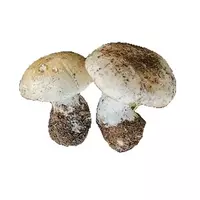May mushroom

Subspecies of rows include the May mushroom, which is hunted by experienced mushroom pickers and culinary experts at the height of the season. This is a rather attractive mushroom, large and strong beauty, somewhat reminiscent of cultural champignons and, according to some connoisseurs, not inferior in its taste to the best mushrooms of the summer-autumn period.
The diameter of the cap of the May mushroom can vary from 4 to 10 centimeters, while for young mushrooms the pillow-shaped or hemispherical, relatively regular round shape is characteristic. As the May fungus ages, it opens, often losing symmetry - it can bend upward, taking on wavy outlines. In addition, in dry weather, the cap of the May mushroom is sometimes covered with deep cracks.
In color, the May mushroom is from white to yellowish, in the center it is rather yellow, while on the periphery it is close to white. The May fungus is characterized by a smooth and dry surface. A distinctive property of the white, dense, fibrous, very thick flesh of the cap of the May mushroom is the presence of a strong powdery smell and taste.
Frequent and narrow plates of the May fungus, grown with a tooth, in adult mushrooms differ in light cream color, while in young ones they are almost white. The thick and relatively short leg of this fungus is quite smooth, almost completely coinciding in color with the hat.
The May mushroom begins to bear fruit in mid or late May, actively settling on lawns, clearings and forest edges, as well as in squares, parks, and lawns. This mushroom loves to grow in circles or rows, while forming clearly visible "paths" in the grass cover. However, the May mushroom disappears completely by mid-June.
Regarding the suitability of the May mushroom, it can be said that it is rightfully considered a fairly good edible mushroom. Although some experts argue that this can be argued with, since due to the presence of a specific smell in it, experience is needed to prepare the May mushroom.
They eat May mushroom in different species, with the exception of raw. It is especially tasty if the May mushroom is cooked well (to a ruddy crust) - this contributes not only to an increase in gastronomic qualities, but also to the disappearance of the flour taste. In addition, the May mushroom can be subjected to other types of culinary processing - cook, simmer, preserve (salt and marinate). Many people like to harvest it for future use using freezing and drying methods.
May mushroom 19 kCal
Energy value of the May mushroom (Ratio of proteins, fats, carbohydrates - ju):
Proteins: 1.7 g (~ 7 kCal)
Fats: 0.7 g (~ 6 kCal)
Carbohydrates: 1.5 g (~ 6 kCal)
Energy ratio (b | y): 36% | 33% | 32%
 Español
Español Français
Français Português
Português Русский
Русский 简体中文
简体中文 繁體中文
繁體中文 日本語
日本語 한국어
한국어 العربية
العربية Türkçe
Türkçe Қазақ
Қазақ Deutsch
Deutsch Italiano
Italiano Українська
Українська
